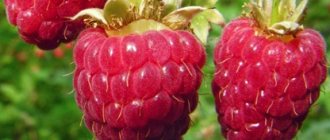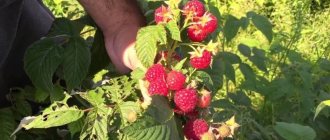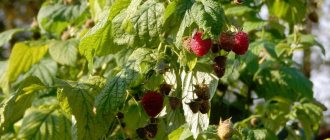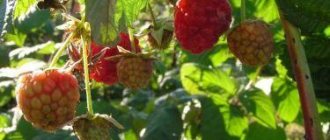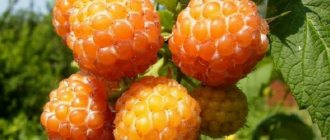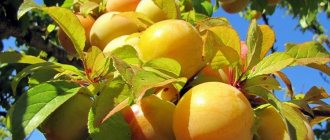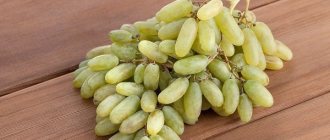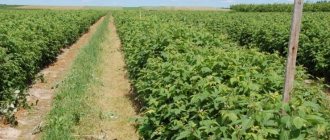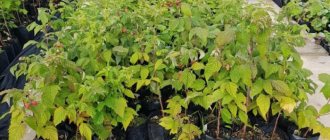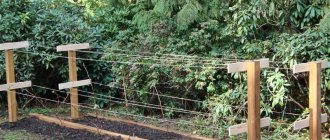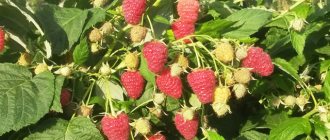The author of the Balsam variety, I.V. Kazakov, called it the best among the early ones - unpretentious, productive and resistant to adverse weather conditions, diseases and pests. For home gardening, the predictability of the behavior of a berry bush is an important advantage of the variety. For more than 30 years, Balsam has been pleasing summer residents with its berries, which are so similar in taste to wild raspberries - with sourness and a pronounced aroma.
Description of Raspberry Balm
It is difficult to meet a person who has not heard about the famous raspberry Balm. This variety was bred 30 years ago, but is still the most popular. Juicy berries are associated with the world famous name of I.V. Kazakov, who developed the Balsam raspberry. Today, most gardeners, farmers and just amateurs try to grow this variety.
This berry is not only distinguished by its excellent taste, it has many other advantages. Raspberries are resistant to adverse environmental factors, so they can grow in many climatic regions. The berry is suitable for both fresh consumption and processed form.
Main characteristics:
- The height of the bush can reach 1.8 meters, so it is recommended to cut off the tops in a timely manner;
- The berry size is average, can reach 3 grams;
- From one bush you can collect about three kilograms of berries;
- Raspberries have medium shoots with thorns, so you need to pick the berries carefully;
- The pulp of the berries is quite dense, but at the same time juicy;
- The taste of raspberries is a bit like wild berries;
- Fruit ripening occurs almost simultaneously;
- With proper care, you can reap a rich harvest every year.
Raspberry Balm is famous not only for its taste and aroma, but also for its beneficial properties for the human body. With the help of berries you can treat colds. In addition, raspberries contain a set of useful vitamins and microelements.
Agrobiological characteristics
The plants have an erect or spreading appearance, showing above-average growth vigor, and therefore are capable of reaching a height of up to 1.8 meters. Long stems need to be tied to a trellis, because... otherwise, without support, they bend to the ground under the weight of the crop, and are also damaged due to gusts of strong wind. The shoots have a medium degree of thorniness, so caring for the bushes and harvesting will not be overly difficult. The spikes are short in length, but have increased rigidity and are colored brown. The stems themselves are green in the first year of life, covered with a noticeable layer of waxy coating. In autumn they ripen, acquiring a light brown hue, which persists into the next season. The rate of formation of replacement shoots is good. With the strip method of cultivating bushes, 15-20 young stems grow annually on each linear meter of a row. Raspberry leaves are complex, consisting of three or five simple leaflets, medium to large in size, located on a moderately long petiole. The leaf blades of the variety are flat, oval-pointed, with a wrinkled, bright green matte surface. The back side of the leaves is whitish, and slight pubescence can be seen on it. In addition, along the main veins there are small, light green, soft spurs with greenish-purple pigmentation. Fruit branches of Balsam are formed in the axils of the leaves, mainly in the upper half of the shoots. They are relatively long, not very branched, but up to a dozen ovaries can form on each of them. The color of the laterals is light green, and in good light it is reddish, due to the accumulation of anthocyanin pigment. Single berries are often formed at the tops of the stems. Root growth is formed moderately actively, thanks to which the variety can be classified as a representative of that “golden mean” that does not spread too much over the area, but at the same time provides a sufficient amount of planting material for accelerated reproduction.
According to the method of fruiting, our hero belongs to the traditional varieties, in which the harvest appears exclusively on the growth of the second year. Its fruits ripen quite early, occurring in a short time. Already at the end of June you can enjoy the first ripe berries, and at the beginning of July you can begin mass harvesting. The raspberries are easily separated from the fruit stem, so picking the fruits will not be too tedious. Shedding of berries is not typical for this variety. The overall yield is quite good, exceeding 2 kg per bush or 60-80 centners per hectare of plantings. With a high level of agricultural technology, up to 10 tons of raspberries can be harvested from the same unit of area.
The ripened fruits of Balsam are medium, but very even in size, wide-conical in shape, 17-18 mm high and 19-20 mm in diameter. Their typical weight is 2.5-3 grams, the color is dark purple or ruby, with a matte surface. The drupes are of moderate size, well fastened together, and do not fall apart under mechanical influence of moderate force. The pulp is quite dense, sweet, with a barely noticeable sourness in the aftertaste. Its sugar acid index is high, consistently exceeding 7 units. The aroma is pronounced, reminiscent in its character of the fragrance of wild berries. It manifests itself especially strongly when the bushes are well illuminated by the sun's rays. The same plants that were grown in the shade are not distinguished by this splendor. As a percentage, the dry matter content in the berries is 9−9.5%, the sum of sugars is 7.3%, and titratable acids are 1.1%. In addition, biochemical analysis shows the presence in 100 g of this raspberry 130 mg of anthocyanins, 25-30 mg of vitamin C, and about 70 mg of vitamin P. When eating, the seeds may be slightly felt, which causes some discomfort and reduces to some extent the gastronomic advantages of the fruit . The average score received by the variety during tasting is 4.2 points.
There are a great many options for using the harvested Balsam. It is perceived quite well by consumers in its fresh form. Due to the dense pulp and resistance to falling apart into fragments, the fruits retain their shape and presentation well when moved over long distances. This fact is especially appreciated by farmers who cultivate berries for sale, for many of whom our hero forms the basis of their assortment. The strong aroma is another attractive property for buyers and sellers, allowing the berries not to linger on the shelves. Excellent results are also shown by processing raspberries for all kinds of preservation - compotes, preserves, jellies, confitures. All these preparations for the winter take over from fresh fruits their excellent taste, rich color and fragrant bouquet, reminding the cold winter of the colors and smells of summer. And finally, another undoubted advantage of our hero is the excellent ability of his berries to withstand deep freezing, losing no more than 4% of juice when thawing, and maintaining their shape, taste and color. Ascorbic acid is also practically not lost; after defrosting, its level is at least 85% of the original content.
Even a novice gardener can cultivate this variety, thanks to the comparative unpretentiousness of the plants and their ability to grow in a variety of climatic conditions with varying levels of fertility and soil texture. Balsam bushes are not only able to withstand severe frosts without much damage, but also withstand winter drying well, in which low temperatures are accompanied by frequent winds. They also have increased resistance to damping off, which occurs in other varieties of raspberries under high snow cover. Drought and heat resistance are standard for the crop. Resistance to purple spot and spider mite damage is increased. Requires usual protection from other diseases and pests.
Landing
There are no subtleties in planting Balsam raspberries. This plant is not whimsical, resistant to various weather conditions. However, for greater fertility, some general gardening features should be taken into account.
First, you need to choose the right area with the sunny side. Avoid soil with high groundwater levels; raspberries will not grow well. It is best to choose a protected corner of the garden, preferably protected from the winds.
Secondly, raspberries need to be planted in early spring (like all berries). It is important to prepare the soil in the fall. To do this, it is necessary to enrich the soil with fertilizers; natural organic substances are recommended.
Thirdly, it is important to free the soil as much as possible from perennial weeds. Although raspberries are unpretentious, they do not grow well surrounded by other plants!
Fourthly, berry bushes must be planted at a distance of 0.7 meters from each other, and there should be no more than 1.8 meters between rows. In this case, you will get a rich harvest.
It should be noted that Balsam raspberries can grow in one area for quite a long time. But for greater fertility, it is better to change its “place of residence” at least once every 10 years. As we can see from what is described above, anyone can plant and grow berries, even those who are poorly versed in the peculiarities of gardening.
Preparing for winter
Preparing raspberries for winter begins in mid-summer - immediately after the berries are released, the fruit-bearing branches are cut out flush with the ground.
The biggest mistake inexperienced gardeners make is feeding young shoots with nitrogen fertilizers. The bushes will begin to grow, but the young wood will not have time to ripen.
To increase winter hardiness, it is advisable to give the bushes compounds of potassium, phosphorus and other microelements, which are so abundant in wood ash. It is quite enough to give a half-liter jar of ash per 1 m2 of planting - scatter it evenly and loosen the soil a little.
Many years of practice have shown that in the conditions of the Moscow region and the Leningrad region, Balsam raspberries overwinter well without additional shelter for the winter.
In conditions of little snow and harsh winters in the Central region, the Urals and Siberia, it is better to bend raspberry bushes to the ground for a successful and safe wintering.
Conclusion
Raspberry balsam has been grown for more than 30 years; the variety can be called unique. It captivates many with its sour taste with forest notes.
Some consider the berry not sweet and tasty enough, and instead of Balsam they most often plant Hussar or Patricia. Others believe that this variety makes excellent winter preparations. Another important point is that during freezing the berries do not change their natural color.
As for the opinion of experienced agricultural technicians, the Balsam raspberry is resistant to different climatic conditions, and is also resistant to various fungal and parasitic diseases. Despite these characteristics, it is not recommended to be grown on large farms; it is ideal for a summer cottage or small business.
Care
Caring for raspberry balm should be comprehensive. In order to get a good harvest, you need to master several rules:
- Loosening the soil. Ideally, loosening the soil is done once a week. In this case, the earth will always be soft and the raspberries will be able to grow and develop, the roots will “breathe” freely;
- Watering. You need to water the berries quite often, but avoid excessively damp soil, which can lead to rotting of the roots. It is recommended to water the raspberries with organic fertilizers approximately once every two weeks;
- Pruning shoots. In order for raspberries to produce a rich harvest every year, you need to trim the shoots using the Sobolev method (double pruning). To do this, in the first year, pinch off the tops of shoots that reach a height of more than a meter. It is important to carry out the work in a timely manner, preferably at the end of May, but the first week of June is also acceptable. The next year, also in the spring, a second side pruning is done. As a result, you will get delicious juicy berries, with which all the bushes of the plant will be strewn;
- Raspberry treatment. The most dangerous plant pest is the raspberry beetle. This insect does not allow the fruit to develop, as a result of which the berries do not ripen. It is recommended to shake off the beetle on film in the spring or use special means. Flower beetle weevils, stem gall midges and some other insects can also harm the plant. Therefore, it is recommended to regularly inspect the bush, dig up the ground in the fall and treat the soil with 1% Bordeaux mixture.
We can conclude that caring for Balsam raspberries is not difficult. If you do everything in a timely manner, you can enjoy fresh berries, freeze them and make jam!
Agrotechnical measures
The variety is cultivated, like other non-repairing varieties, according to the classic two-year scheme.
In the first year, replacement shoots are formed, which, after overwintering, form a crop in the next season. Among the important points, it is worth noting the need to carefully assess the planting site from the point of view of protecting the future raspberry tree from strong winds that blow snow from the site in winter, thereby reducing the protection of plants in relation to low winter temperatures. You should also not place the crop in lowlands and ravines, where dampness and cold air masses accumulate, increasing the risk of freezing of bushes in the cold season, and fungal diseases in the summer. The soil for planting Balsam must be well cultivated and free of rhizomes of harmful perennial weeds.
On a vegetative raspberry plantation, they maintain cleanliness between the rows, if necessary, carry out watering, fertilizing the plants and the necessary procedures to protect the variety from pathogens, tie the shoots to the trellis, and after harvesting, the two-year-old stems are removed.
Back and forth
Useful properties of raspberry balm
Raspberry Balsam is not just a tasty berry, but also very healthy. Some natural medicines are made specifically from this plant. Due to its rich composition, raspberries have the following properties:
- Antipyretic and anti-inflammatory properties. The berry contains salicylic acid, which belongs to the group of NSAIDs (non-steroidal anti-inflammatory drugs). However, unlike regular aspirin, raspberries do not cause gastrointestinal irritation, so they can be consumed by people with gastritis, peptic ulcers, and Crohn's disease;
- Raspberries cope well with the first symptoms of the flu, especially catarrhal symptoms;
- This berry contains a rich set of vitamins A, B2, PP, E, and is therefore recommended for vitamin deficiencies;
- Raspberries contain folic acid, so they are useful for pregnant women and those who are planning to conceive a child;
- It should be noted that raspberries are an antioxidant that is recommended for various diseases.
You can not only enjoy the taste of your favorite berries, but also prevent various diseases.
Wintering
The culture without cover tolerates winter well even in the Moscow region. Therefore, with the onset of cold weather, the branches are simply tied up. But experienced gardeners do not recommend leaving the shoots bare, especially if the thermometer drops below 30 °C.
To cover, the branches are bent to the ground so that they are under the snow cover, and then pinned. You can cover the top with:
- foliage;
- tyrsoy;
- coniferous spruce branches.
With the onset of spring, the branches are freed, the covering material is removed and a garter is attached to the trellis.
Attention! It is not necessary to bend the branches all the way to the ground, otherwise you can break them.
Reviews
“Hello, my name is Irina. I have been growing Balsam raspberries for three years now and am pleased with the fertility of this plant. The berry is not whimsical, you just need to watch out for various pests. But in a few months you will get delicious raspberries and will be able to prepare them for the winter.”
“Good day, my name is Galina. I have a huge garden in which I have allocated space for Balsam raspberries. This is an amazingly tasty juicy berry with a unique aroma. I’ve been growing raspberries for five years now and they always bear fruit.”
“Hello, my name is Alexey, I am from the city of Orekhovo-Zuevo. My wife and I have been gardening for 15 years. Raspberry Balsam was planted about 10 years ago and we are going to replant it this year. I would like to note that the berry is incredibly tasty and healthy. Cured her many colds.”
Advantages and disadvantages
The variety is highly resistant to external factors and tolerates drought and frost. There is immunity to diseases typical of the crop; pest damage is rare. One of the main advantages of the Balsam variety is its resistance to damping off of berries, which is convenient for regions with early thaws. The plant is extremely unpretentious, but requires regular formation of shoots.
Among the disadvantages, gardeners note the specific taste of the fruit. They resemble fresh raspberries, which is not very convenient for creating some types of preparations. The bush needs high-quality and systematic feeding and thinning from weeds.
